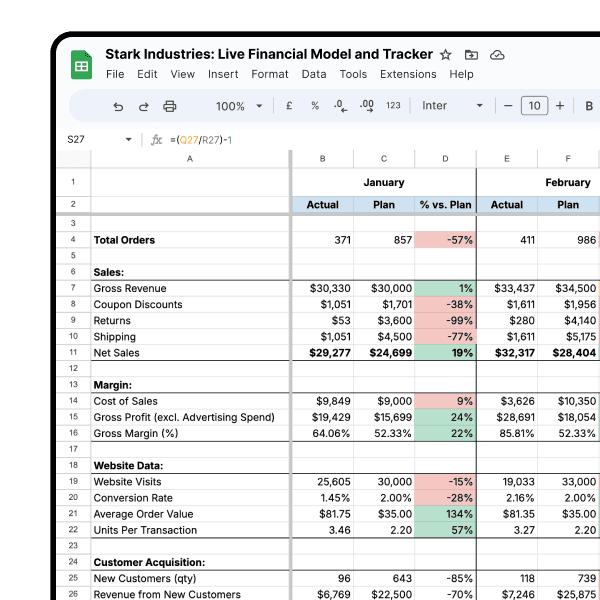Early Stage Growth Tips
03.11.2022
TLDR
Setting the right e-commerce key performance indicators (KPIs) is crucial for online store success. Revenue-related KPIs include Total Sales, Total Orders, Average Order Value (AOV), Shopping Cart Abandonment Rate, Customer Acquisition Cost (CAC), Customer Lifetime Value (LTV), and Top Purchasers. Marketing KPIs encompass Traffic, Bounce Rate, Conversions, ROAS (Return On Ad Spend), and New vs. Returning Customers. Operations KPIs involve Top Products by Units Sold, Product Return Rate, Product Refund Rate, and Top Refunded Products. These KPIs help align your strategy with your objectives.
So you decided to bite the bullet, and started an online direct-to-consumer store. Congratulations! That's no small feat.
Setting the right e-commerce key performance indicators is critical to put your business on the right path. If you measure the wrong KPIs, you will struggle to achieve the right kind of growth.
Some KPIs are pretty intuitive—you know you need to look at sales and revenue data, marketing metrics, orders, and customer information. But there are so many e-commerce metrics out there; which ones should you focus on?
It depends on your business goals. Let's start there.
What are your business goals?
There are a few different reasons why people do business, and it depends on the type of business you're running. Let's look at a few typical ones:
Venture-backed business. These businesses have capital in their early stages, and can afford to run experiments to figure out what works best in their particular product category. Some businesses may focus on building brand equity. Others may offer deep discounts and promotions to drive sales and audience engagement early on. Yet others may invest into research and development to create a truly outstanding product.
Businesses like these tend to focus on marketing and revenue data, to determine the effectiveness of their experiments. They will prioritize sales and revenue over profits.
Bootstrapped business. Businesses that run on founder money will typically aim to hit profitability faster. These businesses often focus on profitable marketing from the get-go, to build brand awareness and encourage sales.
Businesses like these tend to be heavily focused on revenue data and cash flow management. Since they typically work with a lot less money in the bank, they need to focus on effective cash reserves through profits are paramount.
Family business. These businesses are often established, with an existing customer base, but the younger generation may wish to take the business in a different direction. Typically, there is a focus on expansion, adopting new marketing channels and/or sales platforms, and reaching a younger generation of customers.
Businesses like these tend to focus more on marketing data, in order to identify if their new business units have market appeal and therefore the potential to become profitable. They do not usually need to worry as much about immediate profits, as their budgets usually come out of the main business.
Now that you've identified where your business goals may lie, let's look at which e-commerce KPIs would be important to you.
E-commerce metrics and KPIs to track
In this article, we'll only list the metrics and KPIs to track depending on your objectives, to give you an overview of what you should be looking at.
Revenue KPIs
As a company founder, you always want to look at revenue. These are your KPIs to track:
Total Sales—how much revenue was earned from sales on your e-commerce store. See our Gross Sales Hop and Order Performance Report.
Total Orders—how many orders your store generated. See our Gross Sales Hop and Order Performance Report, which also mentions number of products sold.
Average Order Value (AOV)—how much your customer spends on average in a single order. See the KPIs tab on the Airboxr app.
Shopping Cart Abandonment Rate—percentage of people who added item(s) to their cart but left before completing their purchase. See our E-commerce Funnel Performance Hops for Facebook and Klaviyo.
Customer Acquisition Cost (CAC)—total amount needed to acquire a new customer.
Customer Lifetime Value (LTV)—total amount a customer is expected to spend in their lifetime as your customer.
Top Purchasers—the customers who buy the most from your store. See our Top 50 Customers Hop.
Marketing KPIs
If you handle marketing, you need to stay on top of the relevant KPIs. Here's what you want to track:
Traffic—total number of visitors to your store in a given time period. See Sessions under the KPIs tab on the Airboxr App, or our Conversions by Source/Medium Hop.
Bounce Rate—the percentage of people that enter your website and leave without visiting any other pages. See the KPIs tab on the Airboxr App.
Conversions—specifically, e-commerce conversions, i.e. how many site visitors made it to checkout. For an overview across all ad platforms, see our Ad Channel Conversion Performance over Time Hop.
ROAS (Return On Ad Spend)—revenue earned for every dollar spent on a campaign. This helps you adjust marketing budgets. See the KPIs tab on the Airboxr App.
New vs. Returning Customers—how many of your customers are new, compared to repeat customers. See the Insights tab on the Airboxr App.
You can review all the above KPIs against the performance of each of your marketing channels (including CPC, CTR, CPM, conversions and ROAS) using our D2C Marketing KPI Report.
If you have at least six months' worth of data, this will also be useful:
Customer Retention Rate—the percentage of customers who make repeat purchases. See our Cohort Analysis Hop.
Improve your DTC game. Sign up for weekly tips.
Operations KPIs
If product and inventory is under your jurisdiction, here are the KPIs you want to stay on top of:
Top Products by Units Sold—best-selling products by volume over a given period. See our Product Sales Performance Hop.
Product Return Rate—percentage of total products returned during a period of time. See our Gross Sales Hop.
Product Refund Rate—percentage of total products that were refunded during a period of time. See our Gross Sales Hop.
Top Refunded Products—which products get refunded the most.
For more information about each of these metrics, plus industry benchmarks, download our whitepaper Growth Works: 22 E-commerce Growth Metrics.
Want a customized report created for you? Talk to our team.


